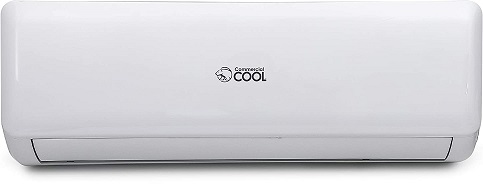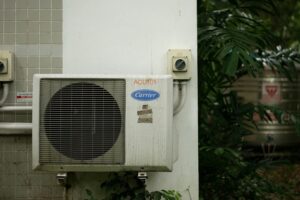Have you ever wondered how a split AC provides cool air in scorching summers or warmth in chilly winters? Well, the functioning of a split AC is a fascinating interplay of thermodynamics, electronics, and mechanics.
It consists of two distinct units, namely an indoor unit and an outdoor unit, which work in tandem to maintain a comfortable temperature inside your home or office.
In this article, we will delve into the intricacies of a split AC’s working mechanism and explore the various components that make it an efficient and reliable cooling and heating system.
Mini Split AC
A mini-split air conditioning system (or ductless air conditioning) is a cooling machine that does not need ductwork to flow air throughout an apartment. It comes with an outdoor unit that houses the compressor and an indoor unit with an evaporator. These two units are linked by a small conduit containing the refrigerant lines and electrical wiring.
The indoor unit is mounted on a wall or ceiling, blowing cool air into the room. Mini-split AC systems can cool individual rooms or zones. They are often used in homes & buildings where ductwork is impractical or where people want to control the temperature in different rooms separately. They are also commonly used in commercial buildings like hotels and offices.
Mini-split AC systems are generally more energy-efficient than traditional central air conditioning systems. They are also easy to install and maintain and can be a good option for retrofitting older buildings with cooling systems.
Components of the Mini-Split
1. Indoor Unit
The indoor unit of a mini-split air conditioning system is the part that is installed inside a building to blow cool air into the room or zone being cooled. It typically consists of an evaporator, a fan, and a filter. The evaporator absorbs heat from the air in the room, and the fan blows the cooled air back into the room. The filter helps to remove dust and other particles from the air.
Indoor units come in various styles, including wall-mounted, ceiling-mounted, and floor-standing. Wall-mounted units are the most common and are installed high up on a wall, usually near the ceiling. Ceiling-mounted units are installed in the ceiling, and floor-standing units are installed on the floor. The type of indoor unit that is used depends on the layout of the building and the preferences of the occupants.
Indoor units of mini-split AC systems are designed to be compact and quiet, so they don’t take up too much space or make too much noise when operating. They are also energy-efficient, and many models come with programmable thermostats that allow users to set the temperature and schedule the system to turn on and off at certain times.
2. Outdoor Unit
The outdoor unit of a mini-split air conditioning system is the part that is installed outside the building. It typically consists of a compressor, a condenser, a fan, and a refrigerant control valve.
The compressor is the heart of the system and is responsible for compressing the refrigerant and increasing its temperature. The refrigerant then flows to the outdoor unit’s condenser, releasing the heat absorbed from the indoor unit and cooling it down. The fan blows air over the condenser to dissipate the heat and keep the refrigerant cool.
The refrigerant control valve controls the refrigerant flow between the indoor and outdoor units, ensuring the system operates efficiently and effectively. The outdoor unit is also designed to be weather-resistant and durable so that it can withstand exposure to the elements.
Working of a Mini Split AC
1. Cooling
The cooling working of a mini-split air conditioning system involves the following steps:
- The indoor unit blows warm air from the room over the evaporator coil containing the cold refrigerant. The refrigerant absorbs heat from the air and evaporates, becoming a low-pressure, low-temperature gas.
- The refrigerant gas flows over the lines to the outdoor unit’s compressor, compressing the gas and increasing its temperature and pressure.
- The high-pressure, high-temperature refrigerant gas flows over the refrigerant lines to the outdoor unit’s condenser, releasing the heat from the indoor unit and condensing back into high-pressure, high-temperature liquid.
- The refrigerant liquid flows back through the lines to the indoor unit’s expansion valve, which controls the refrigerant flow into the evaporator coil.
- The refrigerant passes through the expansion valve and enters the evaporator coil again, repeating the cycle.
As the refrigerant absorbs heat from the warm air in the room, it cools the air and blows it back into the room through the indoor unit’s fan. The procedure is repeated until the user-set temperature is reached in the room.
2. Heating
Mini-split air conditioning systems can also be used for heating and cooling. The heating mode of a mini-split AC system works by reversing the refrigeration cycle used in the cooling mode.
- The outdoor unit absorbs heat from the outside air and transfers it to the indoor unit via the refrigerant lines.
- The indoor unit then blows the warm air over the indoor coil containing the hot refrigerant. The refrigerant releases heat into the indoor air, and it evaporates to become a low-pressure gas.
- The low-pressure gas then flows back to the outdoor unit’s compressor, compressing it into a high-pressure gas.
- The high-pressure gas flows through the outdoor unit’s condenser, releasing the heat and condensing into high-pressure, high-temperature liquid.
- The liquid refrigerant flows back to the indoor unit’s expansion valve, where the cycle repeats.
The heating mode of a mini-split AC system can be very energy-efficient because it uses the heat from the outside air instead of creating heat through combustion. It’s significant to remember that the outside temperature influences the heating mode’s effectiveness. The system may need additional energy in frigid temperatures to provide sufficient heat.
Pros and Cons of a Mini Split AC
Pros of a Mini Split AC:
- Energy efficient: Mini-split AC systems are highly energy-efficient because they don’t use ductwork to distribute air. The absence of ductwork means no energy loss due to leaks or poor insulation.
- Zoned cooling and heating: Mini-split AC systems allow for zoned cooling and heating, which means that each indoor unit can be individually controlled, allowing for more precise temperature control and reduced energy waste.
- Easy installation: Mini-split AC systems are relatively easy to install and require minimal building structure disruption. A small conduit containing refrigerant lines and electrical wiring connects the outdoor and indoor units.
- Quiet operation: Mini-split AC systems are designed to operate quietly, which makes them ideal for use in bedrooms, offices, and other quiet spaces.
- Environmentally friendly: Mini-split AC systems use modern refrigerants that are more environmentally friendly and have a lower impact on the ozone layer.
Cons of a Mini Split AC:
- High upfront cost: Mini-split AC systems can be more expensive than traditional central air conditioning systems, especially if multiple indoor units are required.
- Limited range: Mini-split AC systems are typically designed to cool or heat a single room or a small area. You may need to install multiple units if you have a larger space.
- Requires professional installation: Mini-split AC systems require professional installation, which can add to the system’s upfront cost.
- Regular maintenance required: Mini-split AC systems require regular maintenance to ensure efficient and reliable operation, which can be an added cost.
- May not be suitable for every building: Mini-split AC systems may not be suitable for all buildings, especially if there are space or structural constraints that make installation difficult or impossible.
Conclusion
In conclusion, a mini-split air conditioning system is a versatile and energy-efficient solution for cooling and heating small to medium-sized spaces. These systems offer several advantages over traditional air conditioning systems, including zoned cooling and heating, easy installation, quiet operation, and environmental friendliness. Whether a mini-split AC system is right for you depends on your specific cooling and heating needs, budget, and building constraints. Researching and consulting a professional is essential to determine if a mini-split AC system is the best option for your home or office.
Text taken from: https://www.electronicshub.org






